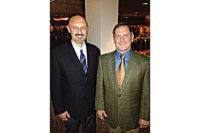AIM/R Reps Wrestle With Supply Chain Changes
The PHCP industry's stellar organization for manufacturer reps, AIM/R, dealt with these and other issues at its 32nd Management Conference, held April 29-May 1 in San Diego. Ferguson Enterprises Senior Vice President/Branch Operations South, Larry Stoddard, set the stage with a keynote address that had the 250 people in attendance buzzing throughout the three-day meeting.
Stoddard repeated the prediction by Ferguson Enterprises CEO Chip Hornsby at last year's ASA Convention that in the next 10 years, the top 10 home builders nationwide will build between 50-75% of all new homes. This will vest enormous purchasing power in those builders, who in turn will try to convince manufacturers to bundle products and ship them direct. “We don't agree with their numbers, but the builders say there is anywhere from 35-55% 'slop' in supply chain margins,” said Stoddard. “Clearly, we need to be more efficient.”
It's not only home builders who are disrupting the industry's traditional ways. Turner Construction, one of the nation's largest GCs, has spun off Turner Logistics as a distribution arm looking to buy product direct. The newly named Home Depot Supply reflects that organization's growing takeover of distribution functions. “Everyone is looking for efficiencies,” said Stoddard. “These things will affect us.”
Stoddard was pinch-hitting for CEO Hornsby, who canceled his keynote address to attend a funeral. Hornsby did show up the following morning for a lively Q & A session with the reps in attendance. He was forthright in revealing Ferguson's thinking. Highlights:
-- Hornsby estimated Ferguson's market share at around 7.5% of all the product sectors in which it participates, and somewhere around double that percentage in plumbing distribution.
-- Ferguson is pleased with its Pro Flo private label line, with products manufactured offshore and aimed at the low-end market.
-- He predicted that e-commerce will make a comeback after initially failing to fulfill its hype.
-- Ferguson is paying a lot of attention to repair and remodeling contractors for business growth. It has concluded that service contractors patronize the big boxes because of availability more than price.
-- Hornsby reiterated Stoddard's assertion about the growing size and clout of home builders. “One wanted a rebate of 15-20% on certain products. Obviously, he didn't understand our margins,” said Ferguson's CEO.
Later in the day, AIM/R attendees heard from Dan Bridleman, vice president of national contracts for KB Home, one of the nation's largest home builders with some 31,000 homes and $6.8 billion in revenues projected for 2004.
Bridleman asserted that “we will leverage volume to have a lot of influence in how we buy … We are looking at anything that eliminates costs.” He hinted in response to one inquiry that might even mean installers who work for distributors.
AIM/R's conference concluded with an innovative “Greet the Press” program, with this reporter and the audience flinging questions at a panel that consisted of ASA President Mark Theis, AIM/R Executive Director Joe Miller and AIM/R member Bill Godwin, one of the principals of Godwin & Schultz Sales in Salt Lake City. Two pre-designated topics were tackled in the session - manufacturer rebates and the viability of the PHCP channel.
Rebates have become troubling to reps due to their proliferation and increasing size - as much as 15-20% in a handful of cases. Moreover, home builders and large contractors also are negotiating rebates based on purchasing power, and to some the practice seems to be spinning out of control. The size of the rebates has led some wholesalers to factor them into their market pricing, enabling some to offer selling prices at or below cost. Reps' commissions get diminished by rebates, which is why they are so concerned. Rebates also tend to distort recordkeeping.
The issue was probed from various directions, including the positive role of rebates in spurring sales of certain products. Nobody could see an end to rebates in the foreseeable future.
Traditional PHCP wholesalers will continue to play a role in the supply chain of the future was the consensus of everyone on the panel. But the central message of this conference reverberated in everyone's thoughts throughout - costs must be cut, value must be added.
Looking for a reprint of this article?
From high-res PDFs to custom plaques, order your copy today!



